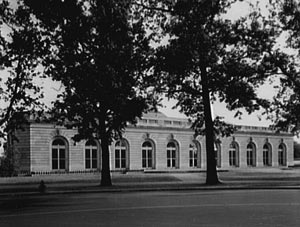
Washington, D.C.
Elms of the National Mallhistory (Botanic Garden “Elm”) continued
The actions leading to the loss of these trees began in 1901, with the plan for the development of Washington, D.C. by the McMillan Commission. Chaired by Michigan Senator James McMillan, the Commission consisted of Daniel H. Burnham, director of the World’s Columbian Exposition held in Chicago in 1893; landscape architect Frederick Law Olmsted, Jr.; architect Charles F. McKim; and sculptor Augustus Saint-Gaudens. The Commission envisioned a return to L’Enfant’s “Grand Avenue,” calling for an open, grassy vista leading to the Capitol, flanked by four rows of American elm trees on either side. The McMillan Commission’s recommendations were in large part a response to the makeshift construction projects completed in and around the Mall during the previous century. However, because it occupied the prominent position just west of the Capital grounds, the Botanic Garden proved a severe obstacle to the Commission's tapis vert (green carpet) design for the Mall.

Courtesy Library of Congress
By the time the McMillan Commission's plan was being developed, the Botanic Garden grounds had fallen into a severe state of disrepair due inadequate funding and maintenance. The McMillan Commission determined that the Botanic Garden grounds would become the site of Union Square, a monument to Federal victory in the Civil War. The centerpiece of the square’s design, the enormous equestrian statue of General (later President) Ulysses S. Grant, was installed in 1922 and the statue of Major General George Gordon Meade, the victor of the 1863 Battle of Gettysburg, followed in 1927. The unkempt and overgrown Botanic Garden seemed unsightly next to the massive new monuments. Subsequently, in 1930, the structures and plantings were demolished and removed in 1930 and Union Square was re-landscaped.